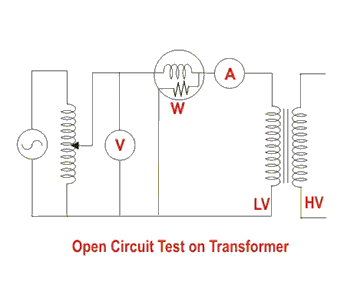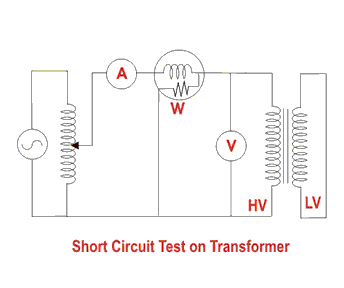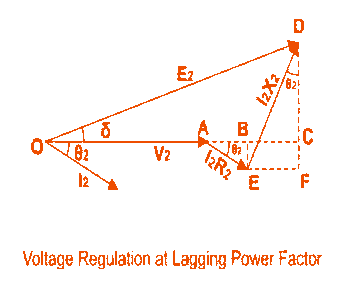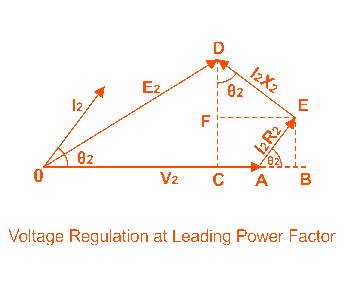Explain how the
efficiency and regulation of a transformer can be assessed by open and short
circuit tests.
What is meant by
equivalent resistance?
Open Circuit Test and Short Circuit Test on Transformer
These two tests are
performed on a transformer to determine
(i) equivalent circuit of transformer (ii)voltage regulation of transformer (iii)
efficiency of transformer.
The power required
for these Open Circuit test and Short Circuit test on transformer is
equal to the power loss occurring in the transformer.
Open Circuit Test on
Transformer
The connection
diagram for open circuit test on transformer is shown in the figure.
A voltmeter, wattmeter, and an ammeter are connected in LV side of the
transformer as shown. The voltage at rated frequency is applied to that LV side
with the help of a variac of variable ratio auto transformer. The HV side of
the transformer is kept open. Now with help of variac applied voltage is slowly
increase until the voltmeter gives reading equal to the rated voltage of the LV
side. After reaching at rated LV side voltage, all three instruments reading
(Voltmeter, Ammeter and Wattmeter readings) are recorded. The ammeter reading
gives the no load current Ie. As no load current Ieis quite small compared to
rated current of the transformer, the voltage drops due to this electric
current then can be taken as negligible. Since, voltmeter reading V1 can
be considered equal to secondary induced voltage of the transformer. The input
power during test is indicated by wattmeter reading. As the transformer is open
circuited, there is no output hence the input power here consists of core
losses in transformer and copper loss in transformer during no load condition.
But as said earlier, the no load current in the transformer is quite small
compared to full load current so copper loss due to the small no load current
can be neglected. Hence the wattmeter reading can be taken as equal to core losses
in transformer. Let us consider wattmeter reading is Po.

Po = V1 2/Rm
Where Rm is shunt branch resistance of transformer.
If, Zm is shunt branch impedance of transformer.
Then, Zm = V1/ Ie.
Therefore, if shunt branch reactance of transformer is Xm
Then, (1/ Xm)2 = (1/ Zm)2 - (1/ Rm)2
These values are
referred to the LV side of transformer as because the test is conduced on LV
side of transformer. These values could easily be referred to HV side by
multiplying these values with square of transformation ratio.
Therefore it is seen
that the open circuit test on transformer is used to determine core losses
in transformer and parameters of shunt branch of the equivalent
circuit of transformer.
Short Circuit Test on Transformer

The connection
diagram for short circuit test on transformer is shown in the figure.
A voltmeter, wattmeter, and an ammeter are connected in HV side of the
transformer as shown. The voltage at rated frequency is applied to that HV side
with the help of a variac of variable ratio auto transformer. The LV side of
the transformer is short circuited . Now with help of variac applied voltage is
slowly increase until the ammeter gives reading equal to the rated current of
the HV side. After reaching at rated current of HV side, all three instruments
reading (Voltmeter, Ammeter and Wattmeter readings) are recorded. The
ammeter reading gives the primary equivalent of full load current IL. As the
voltage, applied for full load current in short circuit test on transformer, is
quite small compared to rated primary voltage of the transformer, the core losses
in transformer can be taken as negligible here. Letís, voltmeter reading
is Vsc. The input power during test is indicated by wattmeter reading. As the
transformer is short circuited, there is no output hence the input power here
consists of copper losses in transformer. Since, the applied voltage Vsc is
short circuit voltage in the transformer and hence it is quite small compared
to rated voltage so core loss due to the small applied volate can be neglected.
Hence the wattmeter reading can be taken as equal to copper losses in
transformer. Let us consider wattmeter reading is Psc.
Psc = Re.IL2
Where Re is equivalent resistance of transformer.
If, Ze is equivalent impedance of transformer.
Then, Ze = Vsc/ IL.
Therefore, if equivalent reactance of transformer is Xe
Then, Xe2 = Ze2 - Re2
These values are
referred to the HV side of transformer as because the test is conduced on HV
side of transformer. These values could easily be referred to LV side by
dividing these values with square of transformation ratio.
Therefore it is seen
that the Short Circuit test on transformer is used to determine copper
loss in transformer at full load and parameters of approximate equivalent
circuit of transformer.
Voltage Regulation of Transformer
What is Voltage Regulation?
Definition
The voltage
regulation is the percentage of voltage difference between no load and full
load voltages of a transformer with respect to its full load voltage.
Say a electrical
power transformer is open circuited means load is not connected with
secondary terminals. In this situation the secondary terminal voltage of the
transformer will be its secondary induced emf E2. Whenever full load is
connected to the secondary terminals of the transformer, rated current I2 flows
through the secondary circuit and voltage drops comes into picture. At this
situation, primary winding will also draw equivalent full load current from
source. The voltage drop in the secondary is I2Z2 where Z2 is the
secondary impedance of transformer. If now, at this loading condition any
one measures the voltage between secondary terminals, he or she will get
voltage V2 across load terminals which is obviously less than no load
secondary voltage E2 and this is because of I2Z2voltage drop in the
transformer.
Expression of Voltage
Regulation of transformer
Expression of Voltage
Regulation of Transformer, represented in percentage, is
|
Voltage
regulation (%) = |
E2 −
V2 |
X
100% |
|
V2 |
Voltage Regulation of
Transformer for lagging Power Factor
Now we will derive
the expression of voltage regulation in detail, say lagging Power Factor of the
load is cosθ2,
that means angle between secondary current and voltage is θ2

Here, from the above
diagram,
OC = OA + AB + BC
Here, OA = V2
Here, AB = AEcosθ2 =
I2R2cosθ2
and, BC = DEsinθ2 =
I2X2sinθ2
Angle between OC
& OD may be very small so it can be neglected and OD is considered nearly
equal to OC i.e.
E2 = OC = OA +
AB + BC
E2 = OC = V2 +
I2R2cosθ2 +
I2X2sinθ2.....................1
Voltage Regulation of
transformer at lagging power factor,
|
Voltage
regulation (%) = |
E2 −
V2 |
X
100% = |
I2R2cosθ2 +
I2X2sinθ2 |
X
100% |
|
V2 |
V2 |
Voltage Regulation of
Transformer for Leading Power Factor
Let's derive the
expression of voltage regulation with leading current, say leading Power Factor
of the load is cosθ2, that means angle between secondary current
and voltage is θ2

Here, from the above
diagram,
OC = OA + AB −
BC
Here, OA = V2
Here, AB = AEcosθ2 =
I2R2cosθ2
and, BC = DEsinθ2 =
I2X2sinθ2
Angle between OC
& OD may be very small so it can be neglected and OD is considered nearly
equal to OC i.e.
E2 = OC = OA +
AB −
BC
E2 = OC = V2 +
I2R2cosθ2 −
I2X2sinθ2.....................2
Voltage Regulation of
transformer at leading power factor,
|
Voltage
regulation (%) = |
E2 −
V2 |
X
100% = |
I2R2cosθ2 −
I2X2sinθ2 |
X
100% |
|
V2 |
V2 |